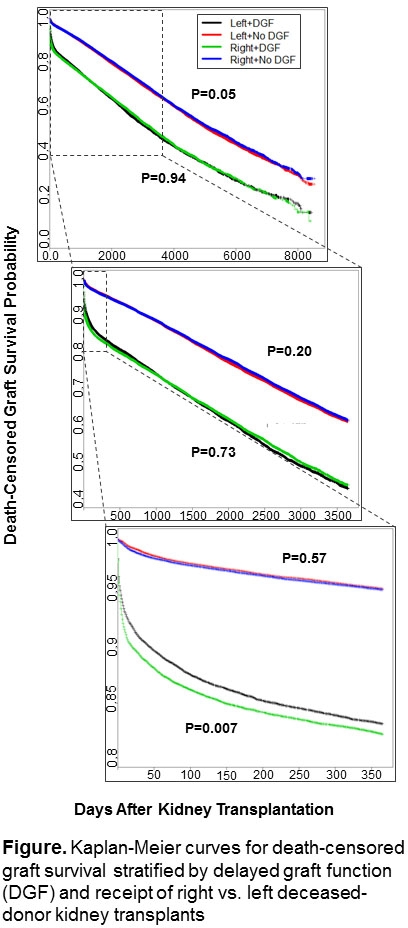Right-Sided Kidney Transplants Are Associated With Early Graft Failure in the Setting of Delayed Graft Function
Yale University, New Haven, CT.
Meeting: 2015 American Transplant Congress
Abstract number: C226
Keywords: Graft failure, Graft function, Kidney transplantation
Session Information
Session Name: Poster Session C: Surgical Issues/Ureteral Complications
Session Type: Poster Session
Date: Monday, May 4, 2015
Session Time: 5:30pm-6:30pm
 Presentation Time: 5:30pm-6:30pm
Presentation Time: 5:30pm-6:30pm
Location: Exhibit Hall E
Anatomical differences between right and left kidneys may affect transplant outcomes. We sought to determine if the right kidney (RK) tends to have worse graft survival than the left kidney (LK) from the same donor relative to delayed graft function (DGF).
Using Organ Procurement and Transplantation Network data, we performed paired analyses of adults who received deceased-donor transplants between 1990 and 2011. We included recipients of single kidneys, matched (RK vs. LK) to the same adult donor, and excluded multi-organ transplants. We fit multivariable conditional logistic regression models for DGF as a function of receiving the RK. We stratified the cohort by DGF and fit separate multivariable Cox proportional hazards models (conditional on the same donor) for death-censored graft failure (dcGF) as a function of receiving the RK (operationalized as a 6-month time-varying covariate).
The 66,643 recipient pairs shared the following donor characteristics: mean age of 40±15 years, 59% male and 8% with cardiac death. Average recipient characteristics for RK versus LK transplants were numerically similar. DGF occurred more often for RKs (27% vs. 25% for LKs, P<0.001). Compared with LKs, the adjusted (conditional) odds ratio for DGF with RKs was 1.17 (95% CI: 1.14–1.21). With DGF, the adjusted hazard ratio (aHR) for dcGF with an RK in the first 6 months was 1.15 (1.04–1.26) and then 0.84 (0.73–0.96) thereafter. In the absence of DGF, aHRs for dcGF were non-significant at 1.06 (0.97–1.16) and 0.92 (0.84–1.01) for RKs in the first 6 months and thereafter, respectively.
Conclusions: Compared with the LK, receipt of the RK from the same donor is associated with DGF, which is a known risk factor for graft failure. Graft survival appears unaffected by donor kidney side in the absence of DGF. When both recipients from the same donor develop DGF, however, the RK recipient is at a slightly higher risk of graft failure in the first 6 months. Beyond 6 months, the RK may have a modest survival advantage. Despite statistical significance, these relatively small differences in outcomes suggest that deceased-donor kidney side should not be considered an important factor in the transplant decision-making process.

To cite this abstract in AMA style:
Hall I, Jiang W, Kulkarni S, Parkih C. Right-Sided Kidney Transplants Are Associated With Early Graft Failure in the Setting of Delayed Graft Function [abstract]. Am J Transplant. 2015; 15 (suppl 3). https://atcmeetingabstracts.com/abstract/right-sided-kidney-transplants-are-associated-with-early-graft-failure-in-the-setting-of-delayed-graft-function/. Accessed December 13, 2025.« Back to 2015 American Transplant Congress
